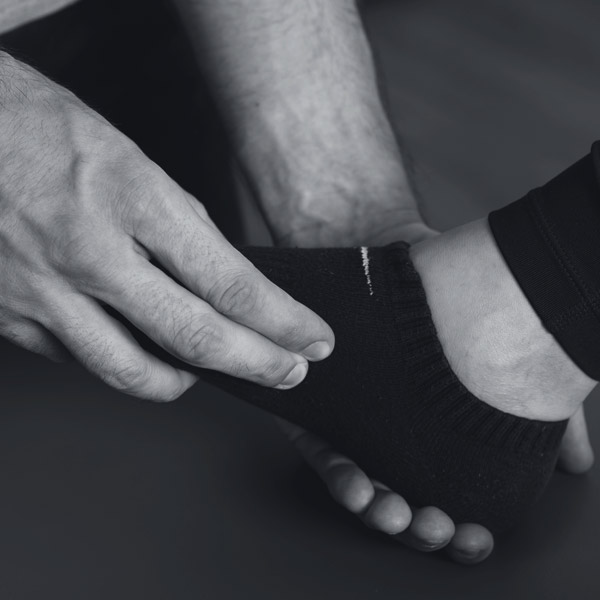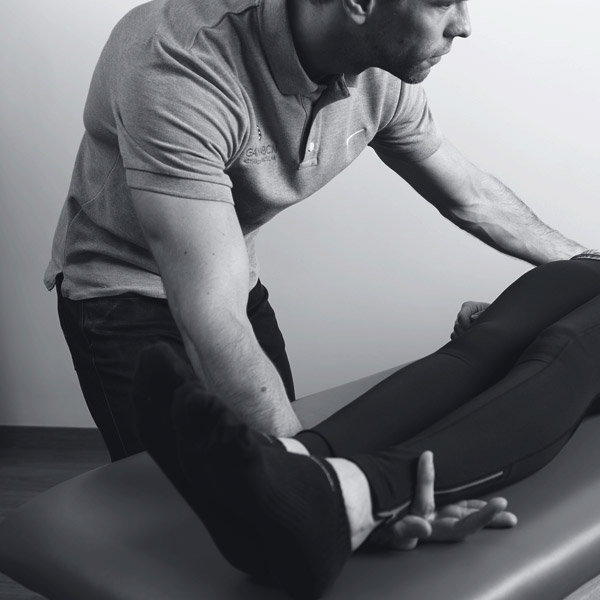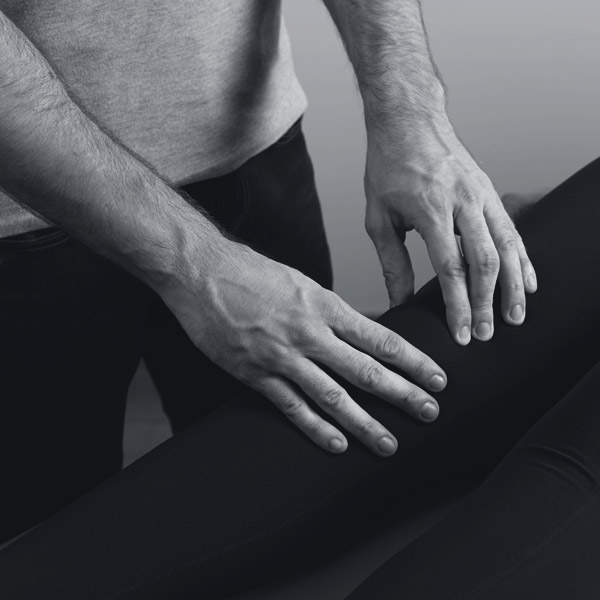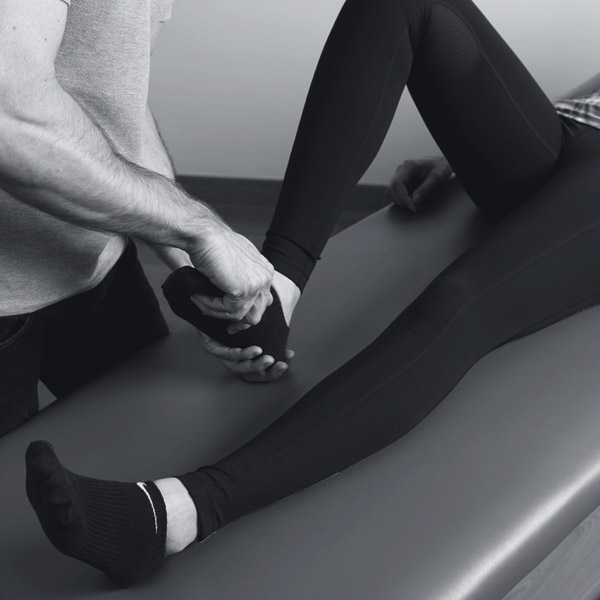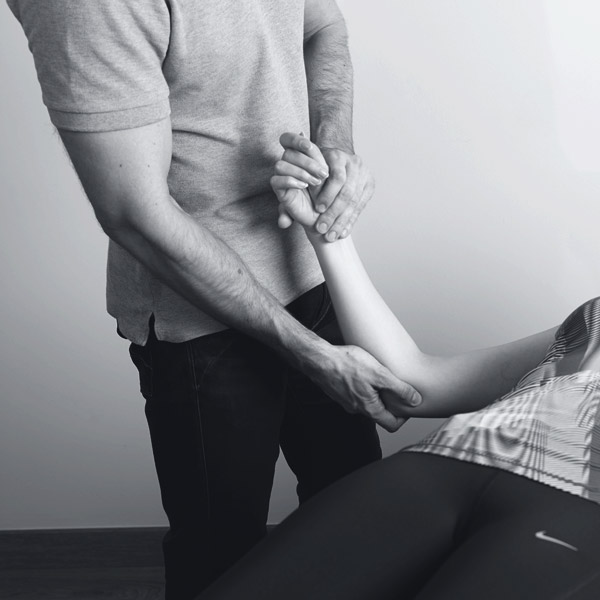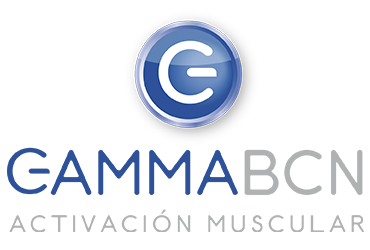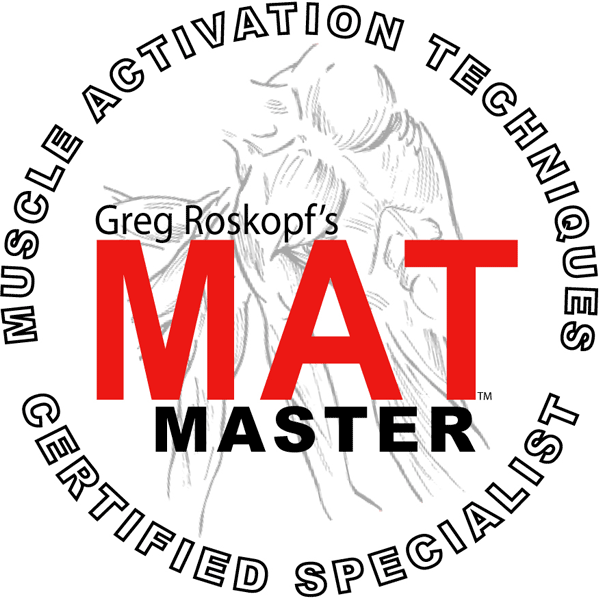MAT®
MAT® is a non-invasive, manual therapy based on biomechanical principles that eliminates the cause of pain, injury or limitation in athletic performance without the need for medications.
Our muscles move and control our joints and allow us to move and keep our posture. Therefore, any misalignment of the muscles’ functioning will alter our body’s movements and how our body accomplishes such movements. Should this situation become chronic, it will develop into pain or injury. MAT® resolves the cause of this misalignment by stimulating the pertinent muscle group found to be contracting improperly.
- Stress of any kind (mechanical: movement repetition, fixed body position for long periods of time, exercise, built up fatigue...; chemically induced: poor nutrition, dehydration, sensitivity or allergy to a certain food item...; emotional: traumatic shock, depressive state); or trauma (surgery, sequelae from a bump/hit) are the causes making a muscle or group of muscles stop behaving optimally.
- MAT® localizes these imbalances with the systematic application of tests or specific muscle tests that disclose, at any given time, how the body is performing by evaluating how the muscles are able to respond. From this information, this technique corrects any imbalance that has been found by means of both manually stimulating the muscle group not contracting optimally and by then performing specific reinforcement exercises of this muscle group.
- Therefore, MAT® DOES NOT pretend to massage the tight muscle area, nor does it focus on the pain or the injury; instead, it eliminates the CAUSE that provokes such SYMPTOMS through manual stimulation and specific reinforcement of those muscles not working properly. In case there is injury of some sort, this technique facilitates recovery because it will eliminate the muscle imbalance that caused it.
Of interest to you
Stress of any type (mechanical: maintaining the same posture for a prolonged period of time, exercise, repetition of a movement, built up fatigue...; chemical: poor nutrition, dehydration, food intolerances...; psychological: emotional shock, psychiatric pathologies, depressive conditions ...); or trauma (sequelae from a bump/hit, surgery...); may cause problems for the proper functioning of our muscles. Our nervous system controls our muscles via sensory receptors located in the muscles that are responsible for maintaining constant communication between the muscles and our bodies. If this is the case, the body’s functioning will be optimal, and there will be control over movements, joints, and adequate tension levels in our body’s muscles. An alteration in this communication will force the nervous system to find solutions for the lack of control over a muscle or a group of muscles. The first manifestation of this imbalance is the limitation in the movement of the joints. This occurs due to the lack of control over the joint as a result of the alteration in the function of the muscles that move this particular joint. If our body does not carry out a movement correctly, it will limit it to prevent us from suffering pain or injury. There will also be increased tension in the muscle or muscles involved. The nervous system will compensate the imbalance in a muscle or muscles by increasing tension in other muscles that will be overused in an effort to replace the functioning of those not doing it properly. If this imbalance continues over time, damage could occur in the muscle or muscles (cramps, tendinitis, muscle tears...) or in the joints (meniscal tears, in the ligaments, a herniated disk...).
MAT® is the ideal tool to reestablish communication between the muscles and the nervous system. It will restore the proper functioning of the body and avoid the occurrence of pain or injury, or it alternatively will ease the recovery process in case pain or injury are present.
ASSESSMENT OF JOINT MOBILITY: The MAT® specialist will apply it to detect asymmetric behaviors between both sides of the body. When some joint shows less mobility, this is a symptom that certain muscles are not performing their job of moving it correctly. This imbalance in certain muscles shows that the nervous system does not have an adequate control of the movement through the affected muscles.
SPECIFIC MUSCLE TESTS: Once some asymmetries and movement limitations have been detected, the MAT® specialist will decide which one to work on. Then, applying specific muscle tests, every single muscle implicated in the movement that has been found to be limited will be evaluated. Using this process, it will be determined whether or not a muscle responds well in its contracting abilities.
MANUAL STIMULATION OF THE MUSCLES: in case that the muscle does not respond contracting itself (there is muscle "inhibition"), it will be "activated" by direct manipulation of the muscle insertions in the bone in order to stimulate the sensory receivers in the muscle that are responsible in maintaining good communication with the nervous system.
RETEST OF "INHIBITED MUSCLES": Then, the specific muscle test will be repeated to see whether the body contracts that muscle once correct communication between this muscle and the nervous system has been reestablished. This process will be repeated with all muscles involved in the joint whose movement was initially limited.
ASSESSMENT OF JOINT MOBILITY: Once the phase of stimulation and reinforcement of the neuro-muscular connection is done, the specialist will again retest the joint mobility. This mobility will have improved substantially to the point that is symmetric with the one on the opposite side of the body, a symptom that the nervous system has more control of the movement. This shows that the specialist has accomplished a change in the functioning of the body by having eliminated the muscle imbalance that caused pain, injury or limitation in athletic performance.
MAT® reestablishes communication between the nervous system and the muscles so that these may contract adequately when moving and managing joints in a proper way.
For movement to happen and be able to be controlled, there must be constant communication between the muscles and the nervous system. This communication can be hindered due to stress (mechanical: repetition of a movement, keeping the same posture for a prolonged period of time, exercise, built up fatigue...; chemical: depressive situation, traumatic shock...) or trauma (surgery, sequelae from a bump/hit...) experienced by our body that causes imbalances in the functioning of our muscles. If we experience any of these, the first consequence will be limitation in joint mobility, which is the result of lack of control over the joints due to an alteration in the functioning of the muscles involved in their mobility. If our body does not perform a movement properly, it will limit it in order to protect us from harm or injury. There will also be an increase in tension in some muscles. The nervous system will balance out the malfunction of a muscle or a group of muscles by increasing tension in some others that will become overused to compensate for those not working properly. If this imbalance is prolonged in time, there could be harm done in the muscle or muscles involved (strains, tendinitis, muscle tears) or the joint (meniscus tears, torn ligaments, herniated disks...). Therefore, MAT® will help avoid this situations by accomplishing an adequate muscle balance. If harm has been done, MAT® will remove the imbalances that caused the harm allowing a fast recovery without risk for relapse.
It is a tool that allows us to evaluate analytically the muscle’s ability to contract. MAT® is a therapy based on the systematic application of muscle tests as a way to find out whether a muscle or group of muscles function properly and a way to stimulate a specific muscle when it shows a deficit in its ability to contract. The goal of each one of these tests is to evaluate a specific muscle so that it can be completely isolated and allow us to be precise in determining what happens at any moment. This tool allows us to see whether there is any muscle imbalance that hinders the body’s ability to move and properly control its joints and therefore predisposing it to experience pain, injury o limitation in athletic performance.
Muscle tests are the best way to get rid of weak links because they evaluate all muscles of the body, one by one, to detect and address any present alteration that may cause harm or limitation in the ability to perform athletically. This tool gives us insight into the "why" of all these problems by providing us with information of the "how" a muscle is performing so that we may specifically target and address the particular anomaly once detected.
Our muscles are equipped with sensors responsible for keeping ongoing communication with the nervous system in the same way that a car has a rain sensor. So, when it rains, this sensor in the car detects it and the windshield wiper activates itself. In our body, when the nervous system is constantly receiving information about the condition of the muscles via these sensors in them, the nervous system will have control over the muscles and will use them when needed with the necessary and required tension.
A problem occurs when this communication is interrupted. Stress of any type (mechanical: maintaining the same posture for a prolonged period of time, exercise, repetition of a movement, built up fatigue...; chemical: poor nutrition, dehydration, food intolerances...; psychological: emotional shock, psychiatric pathologies, depressive conditions ...); or trauma (sequelae from a bump/hit, surgery...) are factors that may directly compromise the connection between muscles and the nervous system. This fact will affect the muscle’s ability to function optimally and will modify the adequate control and movement of our body and joints. These circumstances will be the perfect ecosystem for the manifestation of pain, injury, or limitation in athletic performance. MAT® addresses muscle imbalances that cause this situation or helps in the recovery process after pain or injury have occurred.
Testimony Dr. Alejandro Godall Arteaga, 50 years old. Specialist in medicine and sports orthopedics.
About a year ago, I contacted Carlos through a friend who was being treated with MAT®. I had heard of this technique as means for recovery but I did not know anyone who would apply it as the sole method for recovery. As a patient myself, I had undergone other treatments (massage therapy, osteopathy, fascia stretching, unblocking of the spine area...) to improve the tendency of having muscle cramps in my neck and back without any true success and, as a result, I decided to entrust myself to Carlos and experience MAT® first hand. I was surprised by the "simplicity" of the technique itself but that it required a deep understanding and thorough knowledge of muscle structures in the body that requires substantial education in that regard. As weeks passed by, I experienced improvement in the areas of pain, both in my muscle cramps and a pyramidal syndrome I suffered, and a certain stiffness in one shoulder at the scapulothoracic and glenohumeral level, sequelae of a glenohumeral luxation with trochiter fracture I suffered 15 years ago.
I decided to refer some of my patients with various etiologies, back pain with or without structural alterations of the spine, joint stiffness, muscle injuries... and I can say that the outcomes were very satisfactory.
This is a virtually non-aggressive technique that accomplishes neuromuscular activation and as a result muscle balance in the body, and as any treatment of this kind, it needs continuity for a period of time to accomplish the desired results, a period of time that varies depending on the pathology to be treated.
My impression as a patient and health professional is very positive and I currently recommend this rehabilitative technique to patients I think they need it, embracing a wide range of muscle-skeletal pathologies.
